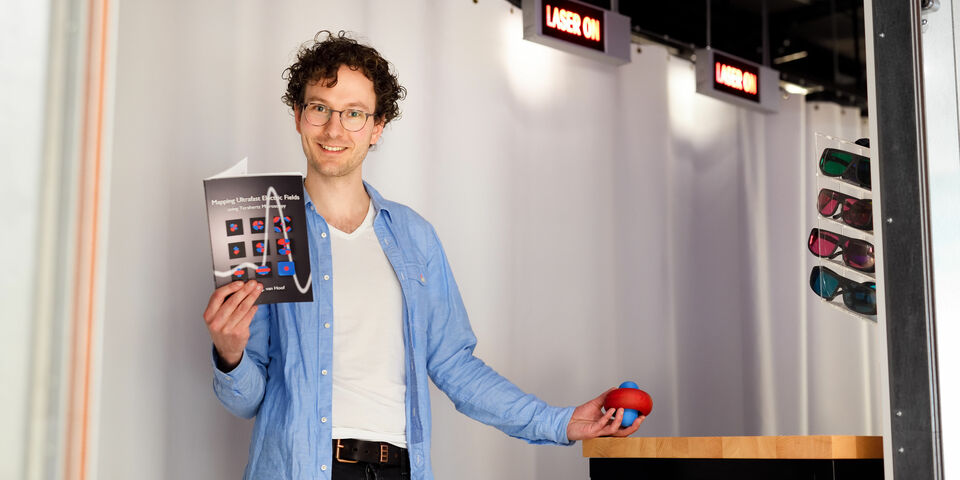Home Stretch | Microscopy with millimeter waves
With a wavelength of about half a millimeter, terahertz radiation fills the gap between visible light and radio waves. This radiation lends itself very well to the in-depth measurement of the electrical properties of new materials, as doctoral candidate Niels van Hoof has demonstrated. He helped build a unique terahertz microscope that can be operated - handy in a pandemic - entirely remotely.
From a scientific perspective, terahertz radiation is an oddball: caught between childhood and adulthood, you could say. Or rather its waves are too short for electrical engineering and too long for physics. In view of this, physicist Niels van Hoof, who carried out his doctoral work in the Surface Photonics group led by Jaime Gómez Rivas (Applied Physics), was also in touch with the group headed up by Professor Marion Matters at Electrical Engineering.
“The two groups even created a spin-off together, TeraNova,” he says. “The company is managing the commercial launch of the terahertz microscope that we developed.” The cross-pollination between the two blood groups, each with its own jargon, makes the specialist field of terahertz radiation particularly interesting, finds Van Hoof.
Body scanners
Beyond the laboratory, terahertz radiation is known mainly in connection with the body scanners used at airports. Many objects are transparent to terahertz radiation, the doctoral candidate explains. “But metals behave like a perfect mirror for this radiation because they conduct electricity. This makes terahertz radiation highly suitable for detecting weapons.”
This sensitivity to electrical conductivity adds another application to the terahertz radiation portfolio: studying materials newly produced in the lab. Think of all kinds of fancy structures like nanowires, which by virtue of their particular form and composition exhibit special electromagnetic properties.
To analyze these new materials, we need to zoom in, as it were, on the object. This can be done using a technique called near-field spectroscopy, a method that has been used successfully in light microscopy for half a century. Here, structures smaller than the wavelength of the light being used are made visible.
Surface
“By applying this technique to terahertz radiation we can detect the electrical fields on the surface of structures that are much smaller than the wavelength of the radiation,” explains Van Hoof. “This enables us to achieve a resolution of between three and ten micrometer.” In the measurement setup the sample moves past a detector in steps of ten micrometers while being illuminated by pulses of terahertz radiation. “This enables us to measure the local electric field as a function of time. We use this information to understand why the material behaves in a certain way.”
Measurements like this are almost impossible to perform with visible light, says the physicist. “In the optical domain you have no choice but to simulate behavior, whereas we can actually measure it. The nice thing about the system is that it is scalable; this means that when working with smaller structures and the correspondingly higher frequencies you can, in principle, expect the same behavior. And so our measurements taken with the terahertz microscope are also relevant to other parts of the electromagnetic spectrum.”
Laser pulse
One field of inquiry involved Van Hoof studying a range of materials, including one made of loosely woven silver nanowires. “Cheap, transparent electrodes could possibly be made from this material, for use in, say, flexible plastic solar cells,” he explains. “While we can't see any individual nanowires with our microscope, we can determine the relevant electrical properties. I've worked with DIFFER on this; they make these kinds of materials.”
As a second field of inquiry he studied the purity of semiconductor material. “You can establish this purity by measuring how long the material remains conductive after you hit it with a short, intense pulse of laser light. The longer the time, the purer the material. This is interesting information for the semiconductor industry. We have devised a way of doing this without the laser pulse damaging the detector. This is so unique that a patent has been granted.”
Remote operation
Similarly unique is the fact that the measurement setup built by Van Hoof can be operated entirely remotely - over the internet. As explained in the short film below, this proved very useful during the last phase of his research; after all, this coincided with the lockdowns during the corona pandemic.



Discussion